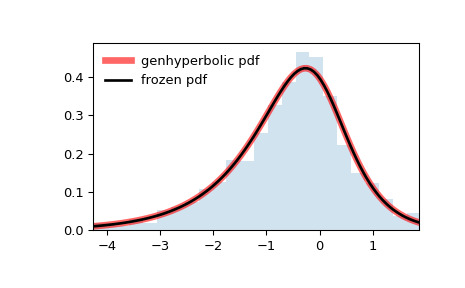本文简要介绍 python 语言中 scipy.stats.genhyperbolic 的用法。
用法:
scipy.stats.genhyperbolic = <scipy.stats._continuous_distns.genhyperbolic_gen object>#广义双曲连续随机变量。
作为
rv_continuous类的实例,genhyperbolic对象从它继承了一组通用方法(完整列表见下文),并用特定于此特定发行版的详细信息来完成它们。注意:
genhyperbolic的概率密度函数为:对于 , 如果 , 如果 。 表示第二类和阶的修正贝塞尔函数(
scipy.special.kv)genhyperbolic将p作为尾部参数,a作为形状参数,b作为偏度参数。上面的概率密度在“standardized” 表格中定义。要移动和/或缩放分布,请使用
loc和scale参数。具体来说,genhyperbolic.pdf(x, p, a, b, loc, scale)等同于genhyperbolic.pdf(y, p, a, b) / scale和y = (x - loc) / scale。请注意,移动分布的位置不会使其成为“noncentral” 分布;某些分布的非中心概括可在单独的类中获得。广义双曲分布的原始参数化可在 [1] 中找到,如下所示
对于 , , , 如果 , 如果 。
SciPy 中实现的基于位置尺度的参数化基于 [2],其中 、 、 、 和
Moments 是基于 [3] 和 [4] 实现的。
对于像学生 t 这样的特殊情况的分布,不建议依赖 genhyperbolic 的实现。为避免潜在的数值问题并出于性能原因,应使用特定分布的方法。
参考:
[1]O. Barndorff-Nielsen,“双曲线分布和双曲线分布”,斯堪的纳维亚统计杂志,卷。 5(3),第 151-157 页,1978 年。https://www.jstor.org/stable/4615705
[2]Eberlein E., Prause K. (2002) 广义双曲线模型:金融衍生品和风险度量。在:Geman H., Madan D., Pliska S.R., Vorst T. (eds) Mathematical Finance - Bachelier Congress 2000. Springer Finance。施普林格,柏林,海德堡。 DOI:10.1007/978-3-662-12429-1_12
[3]Scott, David J, Würtz, Diethelm, Dong, Christine and Tran, Thanh Tam, (2009), 广义双曲线分布的时刻, MPRA 论文, 德国慕尼黑大学 Library ,https://EconPapers.repec.org/RePEc:pra:mprapa:19081.
[4]E. Eberlein 和 E. A. von Hammerstein。广义双曲线和逆高斯分布:极限情况和过程近似。 FDM Preprint 80,2003 年 4 月。弗莱堡大学。https://freidok.uni-freiburg.de/fedora/objects/freidok:7974/datastreams/FILE1/content
例子:
>>> import numpy as np >>> from scipy.stats import genhyperbolic >>> import matplotlib.pyplot as plt >>> fig, ax = plt.subplots(1, 1)计算前四个时刻:
>>> p, a, b = 0.5, 1.5, -0.5 >>> mean, var, skew, kurt = genhyperbolic.stats(p, a, b, moments='mvsk')显示概率密度函数(
pdf):>>> x = np.linspace(genhyperbolic.ppf(0.01, p, a, b), ... genhyperbolic.ppf(0.99, p, a, b), 100) >>> ax.plot(x, genhyperbolic.pdf(x, p, a, b), ... 'r-', lw=5, alpha=0.6, label='genhyperbolic pdf')或者,可以调用分布对象(作为函数)来固定形状、位置和比例参数。这将返回一个 “frozen” RV 对象,其中包含固定的给定参数。
冻结分布并显示冻结的
pdf:>>> rv = genhyperbolic(p, a, b) >>> ax.plot(x, rv.pdf(x), 'k-', lw=2, label='frozen pdf')检查
cdf和ppf的准确性:>>> vals = genhyperbolic.ppf([0.001, 0.5, 0.999], p, a, b) >>> np.allclose([0.001, 0.5, 0.999], genhyperbolic.cdf(vals, p, a, b)) True生成随机数:
>>> r = genhyperbolic.rvs(p, a, b, size=1000)并比较直方图:
>>> ax.hist(r, density=True, bins='auto', histtype='stepfilled', alpha=0.2) >>> ax.set_xlim([x[0], x[-1]]) >>> ax.legend(loc='best', frameon=False) >>> plt.show()
相关用法
- Python SciPy stats.genhalflogistic用法及代码示例
- Python SciPy stats.genpareto用法及代码示例
- Python SciPy stats.genlogistic用法及代码示例
- Python SciPy stats.gennorm用法及代码示例
- Python SciPy stats.genexpon用法及代码示例
- Python SciPy stats.gengamma用法及代码示例
- Python SciPy stats.genextreme用法及代码示例
- Python SciPy stats.geninvgauss用法及代码示例
- Python SciPy stats.geom用法及代码示例
- Python SciPy stats.gumbel_l用法及代码示例
- Python SciPy stats.gzscore用法及代码示例
- Python SciPy stats.gompertz用法及代码示例
- Python SciPy stats.gibrat用法及代码示例
- Python SciPy stats.gmean用法及代码示例
- Python SciPy stats.gamma用法及代码示例
- Python scipy.stats.gilbrat用法及代码示例
- Python SciPy stats.gstd用法及代码示例
- Python SciPy stats.gaussian_kde用法及代码示例
- Python SciPy stats.gumbel_r用法及代码示例
- Python SciPy stats.gausshyper用法及代码示例
- Python SciPy stats.goodness_of_fit用法及代码示例
- Python SciPy stats.anderson用法及代码示例
- Python SciPy stats.iqr用法及代码示例
- Python SciPy stats.skewnorm用法及代码示例
- Python SciPy stats.cosine用法及代码示例
注:本文由纯净天空筛选整理自scipy.org大神的英文原创作品 scipy.stats.genhyperbolic。非经特殊声明,原始代码版权归原作者所有,本译文未经允许或授权,请勿转载或复制。
